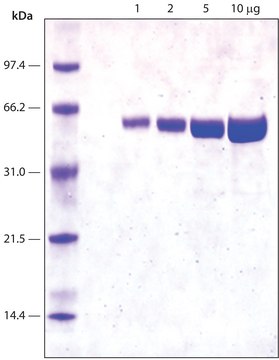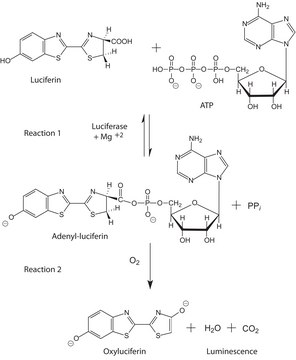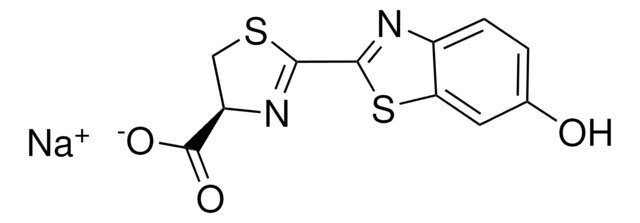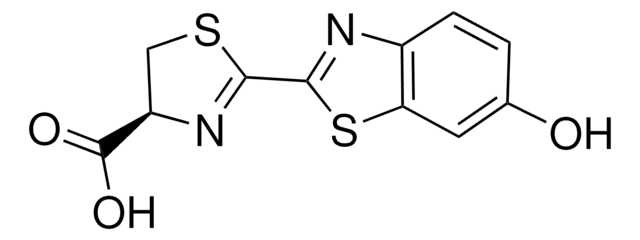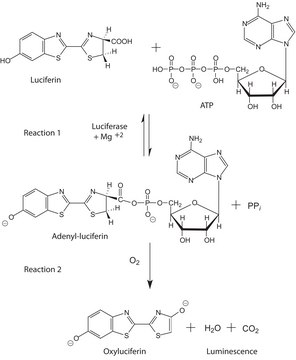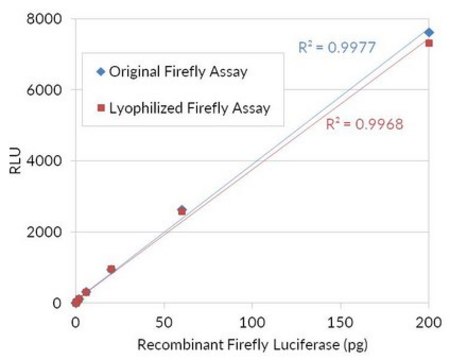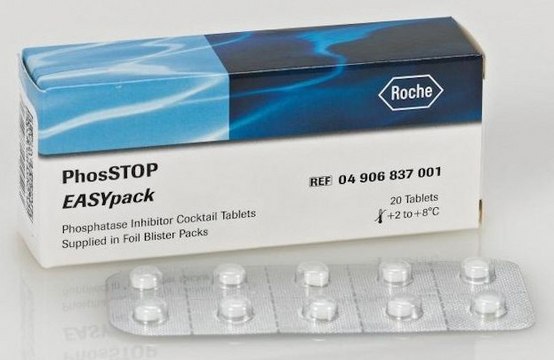L9506
Luciferase from Photinus pyralis (firefly)
BioUltra, ≥98% (SDS-PAGE), lyophilized powder, 15-30×106 light units/mg protein
Synonym(s):
Luciferase firefly
Sign Into View Organizational & Contract Pricing
All Photos(2)
About This Item
CAS Number:
EC Number:
MDL number:
UNSPSC Code:
12352204
Recommended Products
product line
BioUltra
Assay
≥98% (SDS-PAGE)
form
lyophilized powder
specific activity
15-30×106 light units/mg protein
composition
Protein, 10-35% E1%/280
application(s)
diagnostic assay manufacturing
foreign activity
ATPase ≤5 nmol/min-mg protein
Nucleoside diphosphokinase ≤20 nmol/min-mg protein
shipped in
wet ice
storage temp.
−20°C
Looking for similar products? Visit Product Comparison Guide
General description
Firefly luciferase is an enzyme that catalyzes production of light from luciferin in the presence of Mg2+-ATP and oxygen. The reaction of this enzyme with luciferin, ATP, and O2 results in the emission of light.
Application
This enzyme has wide range of applications in biotechnology and development of biosensors. Luciferase can be used to detect trace amounts of ATP and is one of the most commonly utilized reporter genes for the study of gene expression. The bioluminescent reaction catalyzed by luciferase is one of the most sensitive analytical tools for measuring gene expression. Less than or equal to one femtomole of ATP can be detected using 0.2 μg of luciferase. This enzyme has been used in a study to identify the different characteristics of reporter genes in whole-cell bacterial sensors. Luciferase from Photinus pyralis has also been used in a study to develop a novel bioluminogenic assay for α-chymotrypsin.
Biochem/physiol Actions
Luciferase activity can be inhibited by general anesthetics including isoflurane and ketamine/medetomidine thereby affecting the sensitivity of bioluminescence imaging.
Packaging
Sold on the basis of protein content
Other Notes
Arsenate free.
Firefly luciferase is also available in economical recombinant forms (Product Numbers SRE0045 and L9420)
Unit Definition
One light unit produces a biometer peak height equivalent to 0.02 μCi of 14C in PPO/POPOP cocktail. Light units measured in 50 μl assay mixture containing 5 pmol ATP and 7.5 nmol luciferin in Tris-glycine buffer, pH 7.6, at 25 °C.
Physical form
Lyophilized powder approximately 20% protein; balance is primarily NaCl, HEPES buffer salts, and carbohydrate.
Preparation Note
Chromatographically prepared and crystallized.
Analysis Note
Note: Prior to 1991, a unit of firefly luciferase activity was defined as that amount which will produce 1.0 nanomole of pyrophosphate per minute at pH 7.7, 25 °C, using a system containing 0.6 mM ATP and 0.1 mM D-luciferin. The former nanomolar unit is equivalent to approximately 1.3 x 106 light units.
Two contaminant, ATP-consuming activities are assayed for in this product, ATPase and nucleoside diphosphokinase. These impurities are found to be less than 5 nanomolar units/mg protein and less than 20 nanomolar units/mg protein, respectively.
recommended
replacement part
substrate
Product No.
Description
Pricing
Signal Word
Danger
Hazard Statements
Precautionary Statements
Hazard Classifications
Resp. Sens. 1
Storage Class Code
11 - Combustible Solids
WGK
WGK 1
Flash Point(F)
Not applicable
Flash Point(C)
Not applicable
Regulatory Information
常规特殊物品
Choose from one of the most recent versions:
Already Own This Product?
Find documentation for the products that you have recently purchased in the Document Library.
Marleen Keyaerts et al.
PloS one, 7(1), e30061-e30061 (2012-01-19)
Bioluminescence imaging is routinely performed in anesthetized mice. Often isoflurane anesthesia is used because of its ease of use and fast induction/recovery. However, general anesthetics have been described as important inhibitors of the luciferase enzyme reaction. To investigate frequently used
Mehdi Ebrahimi et al.
Applied biochemistry and biotechnology, 168(3), 604-615 (2012-07-20)
Firefly luciferase catalyzes production of light from luciferin in the presence of Mg(2+)-ATP and oxygen. This enzyme has wide range of applications in biotechnology and development of biosensors. The low thermal stability of wild-type firefly luciferase is a limiting factor
David F Fischer et al.
Methods in molecular biology (Clifton, N.J.), 289, 303-314 (2004-10-27)
Protocols to study the regulation of a conserved multigene family (SPRR genes) during calcium-induced differentiation of cultured normal human keratinocytes (NHKs) are provided. Transfection of promoter-reporter (CAT or luciferase) constructs, combined with promoter truncation, can be used to study the
Shu Han et al.
Brain : a journal of neurology, 133(Pt 4), 1026-1042 (2010-04-09)
Blood vessel loss and inflammation cause secondary degeneration following spinal cord injury. Angiopoietin-1 through the Tie2 receptor, and other ligands through alphavbeta3 integrin, promote endothelial cell survival during developmental or tumour angiogenesis. Here, daily intravenous injections with an alphavbeta3-binding peptide
William J Gault et al.
The Journal of cell biology, 207(6), 767-782 (2014-12-24)
Osmotic cues from the environment mediate rapid detection of epithelial breaches by leukocytes in larval zebrafish tail fins. Using intravital luminescence and fluorescence microscopy, we now show that osmolarity differences between the interstitial fluid and the external environment trigger ATP
Our team of scientists has experience in all areas of research including Life Science, Material Science, Chemical Synthesis, Chromatography, Analytical and many others.
Contact Technical Service